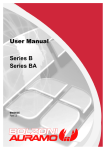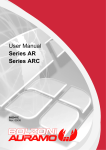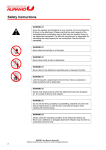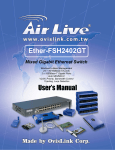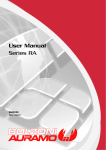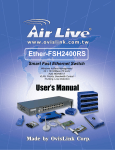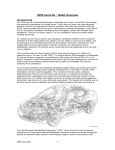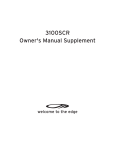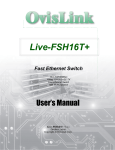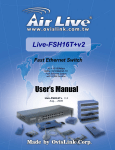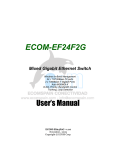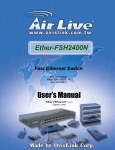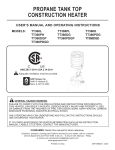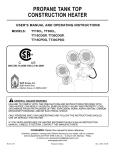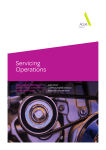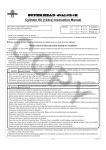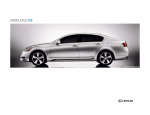Download Service Manual
Transcript
USER MANUAL ROLL CLAMPS TRA-SERIES 960008E 960008E 1. General This manual contains installation, maintenance and service instructions for standard Auramo TRA-Series clamp attachments. Please read this manual carefully before using or servicing this equipment. In this way, you will ensure safe and error-free operation of the clamp attachment right from the start. Make sure that you know how the clamp works before you attempt to use it. Every country has its own safety regulations concerning trucks and truck attachments. It is the responsibility of the user to know and follow these regulations. If safety recommendations given in this manual should differ from your local regulations, you should always follow the local regulations. 1.1 Notices You will find three different levels of notices in this manual: ! WARNING !!! - These paragraphs contain information that will help you to prevent injuries. ! CAUTION !!! - These paragraphs contain information that will help you to prevent damage to the equipment. ! NOTE !!! These paragraphs contain information that will help you to service the equipment. 1.2 Safety Instructions Always check the operating condition of the clamp attachment before use. Never use a defective or damaged attachment. Never stand under a load or clamp attachment. Never stand in the clamp operating area or between the clamping surfaces. Handle only those products with the clamp attachment that it has been designed for. It is unsafe to lift any other objects. Know the capacity and limitations of your machine. 4 960008E 2. Introduction 2.1 AURAMO TRA-Series clamps Auramo TRA-Series clamp attachments have several different models that have been designed to handle 1 to 2 paper rolls in weight ranges between 2200 to 4500 kg (4,900 to 10,000 lbs). All clamps in the Auramo TRA-Series have the following properties in common: • Pivoting arm movement. Several different arm and contact pad options in standard production series. • Optional split-arm design on long arms enables simultaneus handling of two paper rolls with different diameters. • Thin arm profile allows tight stacking with excellent visibility and damage-free handling. • Hydraulic positioning of the short arm improves handling. • Well-proven, 180-degree rotation, with hydraulic cushioning in the vertical positions, eliminates the risk of edge damage. • Rack-and-pinion drive system, with high rotating torque, ensures fast, safe handling. • 90-degree tilt with built-in check valve. • Strong lightweight body, with favorable lost-load center, maximizes the residual capacity of the truck. 2 1 2 1. Clamp body 2. Long arm (split) 3 4 3. Short arm 4. Contact pad Figure: Main components of the TRA-Series clamp attachment 5 960008E 2.2 Nameplate Every Auramo clamp attachment has a unique serial number. This and other identification information can be found on the attachment nameplate, which is fastened to the clamp body. Serial number and clamp attachment type must always be given when ordering spare parts or when making inquiries concerning the clamp. Figure: Nameplate 1. Clamp attachment type 2. Serial number, production year 3. Clamp rated load capacity (= allowed load in kg or lbs at given load center) 4. Clamp weight and center of gravity 5. Effective thickness 6. Maximum operating pressure 7. Roll range (max/min) Serial number is also marked on the fastening plate of the nameplate. ! NOTE !!! A damaged or lost nameplate should be replaced. 6 960008E 3. Installation Instructions 3.1 Truck Requirements 3.1.1 Clamp Attachment Rated Capacity Rated Capacity The rated capacity given for each clamp is a nominal value defined by the clamp construction and clamping force. Rated capacity does not take into consideration properties of the load or working conditions. Therefore, the net working capacity of a truck-clamp combination is not a fixed value. It is defined by the clamp´s rated capacity and the truck's rated capacity at certain heights, loads and working conditions. Net Capacity The lift-truck dealer or manufacturer must calculate the net working capacity for truck-clamp combination. The net capacity can be calculated with a moment calculation method when dimensions and weights of the truck, clamp and load are known. Chapter 9 gives a rough method of calculating the net capacity. Note that the result from calculation is only an approximate one. To get an official result please contact your truck manufacturer. ! WARNING !!! Clamp attachment decreases truck rated capacity. ! WARNING !!! The truck is dangerous to the driver and to persons working near the truck if the driver does not know the net working capacity. Net capacity information must always be visible from the drivers seat. ! WARNING !!! Lift-truck dealers or manufacturers must calculate the net working capacity for your truck-clamp combination. 7 960008E 3.1.2 Hydraulic Pressure Clamp attachment maximum hydraulic pressure is given on the attachment nameplate and on the machine card. Rated capacity is calculated using this pressure. If a lower operating pressure is used, the clamping force will be smaller (and also the rated capacity). If a truck's operating pressure is lower than the pressure required by the clamp attachment, the clamp capacity will also be lower. ! WARNING !!! Never exceed clamp maximum operating pressure without written permission from Auramo. 3.1.3 Oil Flow The volume of oil that flows to the clamp must be as specified. Too small a volume will slow down clamp motions. Too large a volume can cause excessive heating, faulty clamp operation and possible damage to the clamp or truck hydraulic system. Recommended oil flow volumes for Auramo TRA-Series clamps are as follows: Flow Volume Recommendation: TRA-Series Clamp Capacity 2200 - 3500 kg (4,900 - 7,700 lbs) 3500 - 4500 kg (7,700 - 9,900 lbs) Flow Volume 40 - 50 l/min (10.5 - 13 gal/min) 40 - 60 l/min (10.5 - 16 gal/min) 3.1.4 Hydraulic Oils Use petroleum based hydraulic oil as recommended by the truck manufacturer. If you wish to use aqueous-based or biohydraulic oils, please contact Auramo. 8 960008E 3.1.5 Required Hydraulic Functions Standard Auramo TRA-clamps require three hydraulic functions from the truck hydraulic system in order to enable clamping, rotating and tilting motions. 3.2 Handling and Storage of the Clamp Attachment Prior to installation check the clamp carefully for possible damage occurred during transportation. 3.2.1 Lifting the clamp If you have to lift the clamp during installation, make sure that the capacity of your lifting device is adequate. ! WARNING !!! Never go under a hanging load. Beware of load swing when lifting. ! WARNING !!! If the lifting device is attached to one part of a split long arm only, it is possible that long arms may move when the clamp is lifted (TRA-J models only). To prevent this movement, attach the lifting device to all long arm parts or lock all parts together before the lifting operation. 3.2.2 Long Period Storage If for any reason you have to store the clamp for an extended period, follow the instructions given below in order to prevent damage caused by corrosion: n Clean the clamp carefully. n Lubricate and grease all parts that require lubrication (see Chapter 5 for instructions). n Protect all parts that are likely to rust with a suitable 9 960008E corrosion inhibitor or grease. If possible put protective oil into cylinders. n Move arms to a totally open position (so that piston rods are totally in the cylinders). n Protect the clamp from the effects of the weather. Store it inside or under a proper cover. n Check the condition of the clamp during storage and, if possible, regularly run all hydraulic functions of the clamp several times. 3.3 Installation Before installation carry out the following: n Make sure that the truck fulfills all clamp requirements (Section 3.1). n Make sure that the clamp mounting type is the same as the one used on the truck. n Check that the truck's hydraulic oil level is correct. n Check that the truck's hosing and fittings are in a good condition. n Clean the truck carriage. Make sure that it has no defects or wear that could prevent installation or use of the clamp. 3.3.1 Installation, Standard Carriages Installation to the most common standard carriages (types ISO 2328-2, 2328-3, 2328-4) is as follows: n Remove clamp's lower mounting hooks. In quick-change models, open lower mounting hooks. n Lift the clamp to the carriage, so that it hangs from the upper mounting hooks. n Center the clamp horizontally on the carriage. n Install lower mounting hooks. In quick-change models, close lower mounting hooks. n To prevent the clamp from moving on the carriage, two centering blocks are to be welded to the upper carriage bar. 10 960008E n Centering blocks can also be welded to the upper mounting hooks. In which case, the block must be positioned so that it is properly engaged in the mating notch on the truck carriage. In such a case it might be slightly more difficult to center the clamp. Welding instructions come supplied with the clamp. Figure: Positioning centering blocks to the upper mounting hook or to the upper carriage bar. ! WARNING !!! Upper mounting hooks must be properly engaged to the upper carriage bar before fastening lower mounting hooks. If not properly engaged, the clamp might drop. 3.3.2 Installation of Special or Large Mountings Pin type and hook type mountings that are common in larger clamp models are normally installed as follows: n Remove lower pins. n Hang the clamp to the truck carriage from upper hooks or pins. n Center the clamp. n Attach lower pins and bolt pins. n If necessary, weld lower mounting links. ! WARNING !!! Upper mounting hooks must be properly engaged to the upper carriage bar before fastening lower mounting hooks. If not properly engaged, the clamp might drop. 11 960008E Instructions for special mountings can be found in the clamp spare parts book or in separate mounting instructions. 3.4 Hose Flush Flush the truck mast hosing before you install it to the clamp attachment. It is estimated that up to 80% of all defects in hydraulic systems are caused by dirty hydraulic oil. Oil from the mast hoses should be run through the oil filter during the flushing to minimize the amount of debris and dirt in the hoses. n Connect each hose pair with suitable fittings. If needed, use an extra hose. n Turn the truck on and actuate control valves in both directions for about 40 seconds. Figure: An example of a hose-flush connection ! NOTE !!! Hose flushing reduces your service costs in the long run ! 3.5 Connecting the Hoses Dimensions of truck hosing and other hydraulic components must be adequate to meet the needs of a clamp attachment. In this way there are no excessive power losses or damages caused by oil overheating. Avoid 90-degree fittings as these cause large pressure losses. For hydraulic connections, standard TRA-Clamps have a connection block in the clamp mounting side. Size of the fittings (DIN 2353) are as follows: 12 960008E Clamp capacity 0 ... ca. 3500 kg (0 ... ca. 7,800 lbs) • Ø 12 mm (M18x1,5 , 24º) Clamp capacity 3500 kg and up (7,800 lbs and up) • Ø 15 mm (M18x1,5 , 24º) (In US & Canadian models, JIC-8 fittings are used) Clamp hose connections are located as follows (seen from driver´s seat): Figure: Hose connections of the TRA-Series clamp n Attach hoses to fittings as shown in the figure. Make sure that hoses do not twist when attaching the fittings. n Check that hose length is correct. Check that the hoses will not be pressed during operation. n Do not use a smaller hose-bending radius than recommended by the hose manufacturer. ! CAUTION !!! Do not over-tighten hose fittings. Auramo has several hosing accessories that can be supplied on request. For example, hoses of a certain length and equipped with a quick-connection coupling, a four-stage pressure-relief valve (manual or electric) and a magnet valve designed to divide one pressure line between two functions. 13 960008E Figure: Different mast hosing systems 3.6 Air Removal Air in the hydraulic system can cause extra flex or movements in clamp functions. n Remove air by carrying out all movements (clamping, rotation and tilting) several times between respective end positions. ! WARNING !!! Clamp arms can move unpredictably if there is air in the system. 3.7 Checks Before Operating the Clamp Check the mounting and all functions of the clamp before using it for the first time. 3.7.1 Mounting and Clamp Mechanics n Check all parts of the clamp to see that no damage occurred during the transportation. n Check that there are no loose bolts or joints. n Check that installation to the truck is correct. n Check that the clamp is centered to the truck. 14 960008E 3.7.2 Hydraulic Parts n Wipe clean all hydraulic parts. n Run all movements (clamping, rotation and tilting) several times between respective end positions. n Check all cylinders, valves, hoses and fittings for leaks. n Check that hosing is correct, with and without pressure. n Check truck oil level. n Check that split long arms move at the same speed (J-models only), and if necessary adjust the speed (see Section 7.3.5 for instruc-tions). 3.7.3 Clamping-Force Test It is recommended that regular clamping-force tests are carried out in order to minimize the possibility of roll damage. n Check clamping force by using Auramo Test Cylinder. n Check that the clamping force is maintained when clamping for an extended period of time. Leave the pressure on for 5-10 minutes and check for the loss of pressure. Clamping force may decrease up to 10% in ten minutes maximum. Figure: Auramo Test Cylinder for testing clamping force 15 960008E 3.7.4 Clamp Action Test n If possible test all clamp attachment functions with an actual load. n Check that all movements also work when handling a load. n Check the hydraulic system for any leaks or other problems. n Check that the clamping force is correct for the load. 3.7.5 Operation Times It is difficult to give exact values for clamping and rotation times because pump flow volume effects movement speeds. Thus the values given below should be considered as guidelines only. Rotation 180º 4-8 seconds, depending on the clamp size Clamping max-min 4-8 seconds, depending on the clamp size Tilting 90º 4-8 seconds, depending on the clamp size If measured operation times are much slower than given values, check all hydraulic system connections and the pump flow volume. If necessary, contact your Auramo representative. 16 960008E 4. User Instructions 4.1 Clamping the Paper Roll Using Auramo TRA-Series paper roll clamps it is possible to position short and long arms separately. Positioning is carried out using pressure-relief valves that open at different pressure levels, thus only one hydraulic function is needed. In the instructions given below, you will find a description of the operation logic in the opening and clamping operations. 4.1.1 Opening the Arms The short arm begins to open only after the long arm has been opened completely. Therefore, before opening the short arm, the long arm must be open. n Open the long arm fully. n Continue the opening function until the short arm has opened. 17 960008E 4.1.2 Closing the Arms The short arm begins to close only after the long arm is fully closed. Therefore, before closing the short arm, the long arm must be closed. n Close the long arm fully. n Continue the closing function until the short arm has closed. 4.1.3 Clamping a Vertical Roll n Big rolls - Open both arms fully. Drive the truck near the roll into a position where the short arm just touches the roll and the roll leans against the clamp body. n Small rolls - Close the short arm fully, open the long arms sufficiently. Drive the truck near the roll into a position where the short arm just touches the roll. 18 960008E n Grip the roll by closing the long arm. Hold on closing for a couple of seconds to ensure necessary clamping force. Do not pump the valve. n Grip big rolls (= max diameter ... max diameter - 10%) in such a way that the roll touches the clamp body and contact pads. n If possible, grip smaller rolls so that the center of the roll would be on a line that goes through the contact pad centerpoints. n Do not grip the roll too much behind its centerline, as the roll might easily slip off the clamp. Furthermore, do not grip any roll too far in front of its centerline, as this could lead to the clamp frame and the contact pad corners damaging the roll. n Always grip the roll so that the clamp attachment is aligned to the roll. Misalignment easily leads to roll damage. When handling singular rolls and no tilting is required, always grip the roll so that the arms are centered between the ends of the roll. 19 960008E n When handling multiple rolls, a clamp attachment that has split long arms must be used. Grip rolls in such a way that each roll is clamped with own contact pad. n If the roll is to be tilted, it has to be gripped from the lower end. Auramo recommends the use of a separate spacer when wide rolls are tilted as this reduces the risk of roll falling due to too large eccentricity. n Lift the roll high enough before tilting. Be careful not to damage the roll. ! WARNING !!! Never tilt a roll which is too much off-centered. Be careful when tilting wide rolls ! 4.1.4 Clamping a Horizontal Roll n Adjust the opening of the short arm to suit the diameter of the roll. Open long arm sufficiently. Short arm down, long arm up. 20 960008E n Tilt the mast completely forward (ca. 5 - 6 degrees). n Carefully adjust the truck so that the clamp is centered to the roll. n Slowly lower the clamp until short arm just touches the floor. n Slowly approach the roll and stop when the lower contact pad touches the roll. n Grip the roll with the long arm. Tilt the mast back to the vertical position. 21 960008E n Lift the roll and then rotate it to the vertical position. Take care not to damage the roll edges during rotation. ! WARNING !!! Never drive with the roll in a horizontal position. Lift roll high enough before rotating. Keep the roll ca. 30 cm (1 ft.) above the floor when driving. 4.2 Rotating the Roll TRA-Series clamps have a hydraulic cushioning in the vertical positions of the rotation mechanism. This reduces forces that are directed to the roll during rotation. n Grip the roll and lift it high enough before rotating. n Rotate the roll. 4.3 Tips for Safe Operation n Grip the roll correctly. n Drive carefully and safely . Avoid strong acceleration and braking. n Always drive the with the load lowered down and the mast in a vertical or backward-tilt position. Note that too much tilt backward or forward increases the risk of roll edge damage. n When taking a roll from the stack, back away only so far as to be able to lower the roll safely. Never accelerate or brake powerfully when the roll is up, as this can lead to loss of balance. n Do not release the roll before it is in its place. Never allow the roll to fall down. n Beware of slackness in the mast chains. 22 960008E 5. Periodic Maintenance 5.1 Daily Checks Check that there are no leaks, worn hoses or loosened parts in the clamp. Check the clamp frame and arms for defects or cracks. Check that there are no sharp edges on such parts that come into contact with the load. Remove any such edges, for example, by grinding them. Check all arms and contact pads and clean them if necessary. Contact pads should move easily when tested by hand. Check that the clamping force is correct for your load. Use an Auramo test cylinder if necessary. If needed, adjust clamping pressure to suit your needs. Never exceed a clamp's maximum operating pressure. ! WARNING !!! Always check the clamp operating condition before you use it. Never use a defective or damaged clamp. Never exceed clamp's maximum operating pressure. 5.2 Inspection and Service Carry out the following checks and services twice a year or every 300 hours (whichever comes first). ! WARNING !!! In the following service actions the clamp is to be moved hydraulically. Do not leave any body parts between moving clamp attachment parts. Do not remove pressurized parts. Beware of part movements when removing hoses or pipes. Do not climb on the clamp. 23 960008E n Clean the clamp n Carry out all routine tasks mentioned in Section 5.1 n Apply grease to the rotation bearing. Remember to rotate the clamp during this operation. Figure: Rotation bearing grease nipples n Open the cover plate that protects the rotation mechanism. n Rotate the clamp to its end positions and wipe all grease and dirt from the racks and pinion. n Apply grease to racks and pinion, remember to rotate the clamp during the operation. Use brush or an equivalent tool to apply the grease. Figure: Greasing points of the rack and pinion mechanism 24 960008E n Protect all such moving parts that are susceptible to rust (such as springs and pull rods). Apply grease to hinge pins. Be careful not to use too much grease or other lubricants, as these should not be allowed to touch roll or contact pads. n Check the amount of oil in the truck's system, check oil purity and the condition of the oil filter. n Flush mast hoses, see Section 3.4 for instructions. n Check the clamp for parts that might become defective or cause other trouble during the next service interval. Especially check hinge pins and their bushings, contact pads and wear plates. Replace or repair all parts showing signs of excessive wear. In the next section, you will find some guidelines on how to estimate the amount of wear in some parts. Arm pivots (pins, bushings and their seats) When moving arms up and down by hand, the play should be less than 5 mm (0.2 inch) measured from 1000 mm (40-inch) arm length. For longer (or shorter) arm lengths use the following formula: max. play = Arm length in mm * 5 / 1000 (or max. play = Arm length in inch * 0.2 / 40). If the play is greater than this and disturbs normal operations, worn arm bushings or clamp cylinder bushings must be replaced. Rotation mechanism (rack and pinion) The play should be no more than 5 mm (0.2 inch) measured from a 500 mm (20-inch) distance from the torque centre. If the play is greater than this and disturbs normal operations, you have to replace rack and/or pinion. The best and most durable result would be to replace both. You can measure the play by gripping a vertical roll and then carefully (and slowly) trying to rotate it (do not lift the roll in this case). Another method is to rotate by hand a clamp that has been lifted up. 25 960008E 5.3 Tightening the Bolts Bolts on Auramo TRA-Series clamps are secured using LOCTITE 270. Bolts under high stresses are also tightened to a certain fastening torque. In normal cases, retightening of the bolts is unneccessary. Should loose bolts be found during daily checks, open them, apply some LOCTITE 270 to the bolt threads and retighten them. Also remember to check the tightness of bolts within the immediate area. The following bolts are to have the specific fastening torque of: • Mounting bolts M20 torque 540 Nm (55 kpm / 400 lbs-ft) • Rotation bearing bolts M16 torque 280 Nm (29 kpm / 210 lbs-ft) • Pinion bolts M16 torque 280 Nm (29 kpm / 210 lbs-ft) 5.4 Lubricants (Greases) All lubrication points on Auramo TRA-Series clamps are greased using following lubricant: • Mobilplex 47 (or equivalent good quality grease) 26 960008E 6. Trouble Shooting 6.1 General It is estimated that up to 80% of all trouble and defects in hydraulic systems originate from dirty hydraulic oils. In most cases, dirty oil is the reason for various valve problems and excessive wear in seals and o-rings. Because all clamp attachment hydraulic functions move back and forth, it is possible that the same debris might be moving in the oil for a very long time unless special attention is paid to cleanliness. Auramo strongly recommends that the hydraulic oil and oil filters are changed regularly. 6.2 Safety Warnings During all trouble shooting operations, work will be carried out near the clamp. Always work safely. ! WARNING !!! Do not open pressurized components. Hydraulic components can be hot. Use suitable protection. Beware of leaks. High pressure oil can damage the eyes and skin. Always wear protection goggles having sideprotection. Do not remove cartridge valves when pressure is on. Do not put your body parts between or near moving clamp parts. Do not climb on the clamp. 27 960008E 6.3 Hydraulics of the TRA-clamp 6.3.1 Hosing Diagram and Valves, Tilting Hydraulics Figure: Hosing Diagram, Tilting Hydraulics Tilting Valve Block The tilting valve block controls the tilting function. In the figure below the main components and functions of a tilting valve are described. Numbers in the figure correspond to those in the spare parts book. Figure: Tilting Valve Block 1. Pressure relief valve cartridge; This valve is used to control the tilting force when tippling up the roll. 2. Pressure relief valve cartridge; This valve is used to control the tilting force when tippling down the roll. 4. Counterbalance valve cartridge; Prevents the load from tilting too fast (rushing) when tippling down the roll. 28 960008E 6.3.2 Hosing Diagram and Valves, Clamping and Rotation Hydraulics B A B6 A6 Figure: Hosing Diagram, Clamping and Rotation Hydraulics Part A: Clamping Valve Block The clamping valve block controls the arm functions. In the figure below, the main components and functions of a clamping valve are indicated and described. Numbers in the figure correspond to those in the spare parts book. 1 21 20 20 Figure: Clamping Valve Block Main pressure-relief valve cartridge (1): This valve is used to control the clamping force of the clamp attachment. Check-valve cartridge (2 pcs.) (20): One check valve keeps the clamping pressure on and the other one prevents long arms from closing under their own weight (during horizontal lifts). 29 960008E Short-arm pressure-relief valve cartridge (21): This valve also functions as a check valve. This valve controls short arm movements, it allows short arms to move only when long arms are totally open. Part B: Rotating Valve Block The rotating valve block controls the rotation function. In the figure below the main components and functions of a rotating valve are indicated and described. Numbers in the figure correspond to those in the spare parts book. 1 3 1 3 Figure: Rotating Valve Block Flow-control valve cartridge (2 pcs.) (1): Controls the rotating speed of the clamp. Counterbalance-valve cartridge (2 pcs.) (3): Prevents the load from rotating too fast (rushing) during the rotation. 6.4 Trouble Shooting Problem: No pressure in the clamp Possible cause: Hose connection between clamp and truck is defective n Check all connections. If needed, replace them. Possible cause: Failure in the truck hydraulic system n Check that oil is coming from truck hydraulic system. Problem: Pressure is on, arms do not move Possible cause: Incorrect hose connection n Check the hoses. Rectify connections if needed. Possible cause: Dirt in check valve n Clean or replace check valves or short-arm pressure-relief 30 960008E valve. Possible cause: Pressure-relief valve cartridge defective or wrongly set n Replace valve or correct the setting. Possible cause: Leak in pressure cylinders n Check and replace seals if needed. Problem: Pressure is on, rotation does not work Possible cause: Incorrect hose connection n Check the hoses. Rectify connections if needed. Possible cause: Dirt in flow control valve n Clean or replace flow control valves. Problem: Clamping force too low Possible cause: Hydraulic pressure is too low n Check truck pressure settings. Measure pressure coming from the truck. Pressure must be the same as, or higher than, what is required for the clamp. n Check oil level. n Check for external leaks. If needed, clean components before checking. n Blocked hose or fitting. Repair or replace. Possible cause: Wrong setting in the main pressure-relief valve n Check clamping pressure with the Auramo test cylinder. The pressure can be adjusted by turning the adjustment screw (clockwise - pressure increases, counterclockwise - pressure decreases). Never exceed the maximum operating pressure of the clamp ! Possible cause: Leak in check valve n Clean or replace check valves or short-arm pressure-relief valve. Possible cause: Leak in cylinder seals n Replace seals. Possible cause: Too much pressure in tank line n Check hoses and repair if needed. 31 960008E Problem: Clamping force OK, load falls Possible cause: Dirty contact pads n Clean contact pads. Possible cause: Worn or damaged contact pads n Replace contact pads or friction surfaces. Possible cause: Operator error n Check that the load is clamped correctly and that there is no overloading. Possible cause: Wrong clamp for the load n Check if clamp capacity, arm-opening range and arm type are suitable for the load. Problem: Loss of clamping force Possible cause: Leaks in hoses or fittings n Check for external leaks. If needed, clean components before checking. Possible cause: Leak in check valve n Clean or replace check valves or short-arm pressure-relief valve. Possible cause: Leak in cylinder seals n Replace seals. Problem: Clamp arms close or open too slowly Possible cause: Oil flow from the pump is too small or much too big n Check the pump and replace it if needed. Note flow rate recommendation (see Section 3.1.3). Possible cause: Defect in hoses or hoses are too small n Repair or replace with correct sizes. Possible cause: Restrictor valves in the cylinders have wrong setting (J-models only). n Adjust valves. 32 960008E Problem: Short arms move simultaneously with long arms Possible cause: Defect in short-arm pressure-relief valve. n Change valve. If trouble persists, contact Auramo. Problem: Short arms do not move Possible cause: Defect in short-arm pressure-relief valve. n Change valve. If trouble persists, contact Auramo. Problem: Arms move roughly Possible cause: Air in the system n Remove air by fully opening and closing arms several times. Possible cause: Dirt in hydraulic system n Clean system and change oil and oil filter. Problem: Split long arms do not move at the same speed (J-models only) Possible cause: Dirt between arms and body or uneven wear n Clean the clamp. If this does not help, adjust restrictor valves on cylinders (see Section 7.3.5). Problem: Rotation end cushioning does not work Possible cause: Dirt in cushion channel or cushion mechanism n Rotate clamp several times back and forth near the end position. If this does not help, clean cushion channel and mechanism, which are located at the end of the rotation cylinders. See Section 7.3.3 for instructions. Possible cause: Incorrect hose connection n Check the hoses. Rectify connections if needed. 33 960008E Problem: Rotation is too fast or too slow Possible cause: Counterbalance valves are wrongly set n Counterbalance valves can be adjusted using adjustment screws that are located in the cartridge valve. Clockwise faster, counterclockwise - slower. Only screw 1/8 - 1/4 turns at a time and test with load after each adjustment. Both valves have to be adjusted equally. Problem: Tippling does not work Possible cause: Incorrect hose connection n Check the hoses. Rectify connections if needed. Possible cause: Hydraulic pressure is too low n Check truck pressure settings. Measure pressure coming from the truck. It must be the same as or higher than that is required for the clamp. n Check oil level. n Check for external leaks. If needed, clean components before checking. n Blocked hose or fitting. Repair or replace. Possible cause: Counterbalance valve cartridge dirty or defective n Clean or replace the valve. Problem: Tippling stops before its end position Possible cause: Cushion channel in the tippling cylinder is dirty or blocked n Clean the cushion channel which is inside the tippling cylinder. 34 960008E 7. Service and Repairs 7.1 General Auramo Oy and its authorized representatives are anxious to answer all customer questions concerning Auramo service and products. To help us to resolve any problem you may be having as fast and accurately as possible, please check the following information before contacting us: • Clamp attachment type, serial number and production year. This information can be found on the clamp nameplate. • How and under which operating conditions the trouble occurs. • Type of operation, estimated work hours of the clamp. • Any other information you think will help us to help you. 7.2 Notes on Service Actions Clean the clamp carefully before removing or replacing any parts. Protect the environment. Always put used oil into a proper tank. Do not let dirt or debris enter into the hydraulic system. Always protect open fittings with a proper cap. Clean all parts carefully before installing them onto the clamp. 7.3 Service Instructions In the following pages you will find instructions on how to perform such service actions and repairs that are outside the normal maintenance schedule. ! WARNING !!! Read instructions carefully before you do anything. Repairs done incorrectly are safety hazards. Follow all safety instructions given in previous chapters. 35 960008E 7.3.1 Hose Change Due to the minimized body size of the TRA-Clamp it is slightly difficult to change some hoses. Is is possible that before some hoses can be changed, other hoses that are on top of them must be removed. n Clean the clamp carefully before removing or replacing any parts. n If the hose leaks from the fitting, first try to tighten the fitting. Change the hose only if this does not help. n Label all hoses before removing them. This makes reassembly significally easier. n Protect all open fittings with a proper cap. n Make sure that hose length is correct before installing it. Always compare the length of new and old hoses. n Make sure that enough play length is left on the hose before fastening. n Do not over-tighten hose fittings. Over-tightening will easily cause damage to valve blocks or fittings. Make sure that hoses do not twist when tightening the fittings. n Grease the hoses that lie under rack-and-pinion mechanism after their installation. These hoses are in continuous rubbing motion against the clamp frame during the rotation. ! WARNING !!! Never remove pressurized parts or hoses. 7.3.2 Seal Change, Clamp and Tilting Cylinders n Remove hoses, protect open fittings with proper caps. ! WARNING !!! Never remove pressurized parts or hoses. n Remove the cylinder from the clamp. 36 960008E 10 52Z 53 50 W 51 20 52Z 100 Figure: Clamp Cylinder n Open the housing (51). n Pull the piston assembly and housing (20, 100) out of the cylinder shell (10). n Use blunt screwdriver to take old seals away from the piston (50). If necessary cut the seals to remove them. ! CAUTION !!! Do not scratch piston surfaces with sharp tools. Note the direction of the seals. n Open the grub screw (53). If necessary, heat the screw before opening. n Unscrew the piston (50) from the piston rod (20). n Slide the housing (51) off the piston end of the rod. n Remove old seals from housing. ! CAUTION !!! Do not scratch housing surfaces with sharp tools. Note the direction of the seals. n Clean and check piston, piston rod, cylinder shell and housing. See if there are any scratches, wear, corrosion, cracks or other similar damage that could prevent normal operation of the cylinder. n Replace all damaged or worn parts. n Install new seals to the housing. 37 960008E n Oil seals and piston rod. n Slide housing onto the rod from the piston end of the rod. n Install the piston back onto the piston rod. Use LOCTITE 542 to secure the joint. n Screw the grub screw back into piston. Use LOCTITE 270 to lock the screw. n Install new seals on the piston. n Oil the cylinder shell. n Slide piston assembly into the cylinder shell. n Screw the housing into the cylinder shell. n If possible, test run the cylinder before re-assembling it to the clamp. Max. test pressure is 22 MPa (220 bar, 3200 psi). n Check the condition of pin bushings at both ends of the cylinder and replace bushings if necessary. n Re-install the cylinder to the clamp. n Connect hoses. n Test run all cylinder functions. Check for for leaks. 7.3.3 Seal Change, Rotation Cylinders Before changing the rotation cylinder seals, the whole rotation cylinder assembly (both rotation cylinders and their guide parts) must first be removed. n Remove the clamp from the truck and set it to a horizontal position (mounting side down, arms up). n Remove the cover plate. n Label all hoses before removing them. This makes reassembly significally easier. n Remove hoses and pipes, protect open fittings with proper caps. 38 960008E ! WARNING !!! Never remove pressurized parts or hoses. n Use a center punch or similar tool to mark the position of adjustment nuts (40). Hit a mark to every nut and respective position on the clamp frame. This procedure makes reassembly easier. n Unscrew each adjustment nut slightly less than one turn. n Open screws from guide parts. n Lift rotation cylinder assembly from the clamp. Use proper lifting devices only. n Slide guide parts off the cylinder shells. Figure: Rotation cylinder n Pull cylinder shell (10/20) off the rack (30). n Remove old seals from the rack end. ! CAUTION !!! Do not scratch piston (rack) surfaces with sharp tools. Note the direction of the seals. n Clean and check rack, cylinder shell and guide parts. See if there are scratches, wear, corrosion, cracks or other similar damage that could effect normal operation of the cylinder. n Replace all damaged or worn parts. 39 960008E n Check and clean the cushion bushing in the other end of the rack. Clean cushion channel from the other end of the cylinder shell. n Install new seals onto end of the rack. n Apply a thick layer of grease to the rack and seals. n Slide cylinder shell onto the rack. n If necessary repeat the operation with the other cylider shells. n Slide guide parts onto cylider shells. n Check the condition of hoses located under the rotation cylinder assembly. Replace hoses if necessary. Clean and grease these hoses. n Apply a thick layer of grease to the rack-and-pinion teething. n Lift rotation cylinder assembly back to the clamp. Note that cylinders must be in the same position as they were previously. Make sure that centering marks found on rack-andpinion teething are in correct positions, otherwise full 180degree motion will not be attained ! n See that holes in cylinder shell ends settle correctly into centering pins which are located in the clamp frame. n Adjust and fasten guide parts. Make sure that guides settle properly to their seats. n Screw cylinder-shell end adjustment nuts back to their original positions. Use previously made marks to define correct position. n Assemble hoses and pipes. n Attach the clamp back to the truck. Test all rotation functions. Check for leaks. Check that the clamp rotates a full 180 degrees. Check that end-cushionings work. n Fasten the cover plate. 40 960008E 7.3.4 Replacement of Wear Plates The short arms of the TRA-Series clamp have wear plates made of special wear-resistant steel. The purpose of these plates is to protect the short arms from wearing during normal operation. Plates should be replaced before they become totally worn out. n Remove the remnants of an old plate by, for example, grinding. Weld a new plate at the same location. n Check also if there is excessive wear to other parts of the clamp and repair if necessary. Figure: Wear plates and other wearing parts 7.3.5 Split Arm Synchronization TRA-Series clamps with split long arms (J-models) have restrictor valves in long-arm cylinders. These valves enable armmovement synchronization. Restrictor valves are adjusted at our factory but due to operating conditions or wear it is possible that arms may begin to move with different speeds. In such cases, valves must be re-adjusted. n Open fully adjustment screws of both restrictor valves. n Test arm speeds using normal running power. n Slightly tighten the adjustment screw of the faster arm. Test the speed again. Continue adjusting until both arms move at the same speed. 41 960008E 8. Spare Parts Auramo Oy and its authorized dealers supply spare parts for all products manufactured by Auramo. 8.1 Spare Parts Book An unique Spare Parts Book comes with each clamp attachment. This book consists of four main parts: Machine Card Includes attachment definitions as mentioned in the order. The Machine Card also contains the same information as attachment nameplate. Construction List The Construction list is the list of main parts of the clamp attachment. It contains part numbers for sub-construction spare parts. Spare Parts List Contains part numbers and part quantities in sub-constructions. Some parts contain other parts (for example clamp cylinders and valves) and have their own spare parts lists. These lists are referenced in the sub-construction spare parts list. Make sure that correct part numbers are quoted, especially where a part number is dependent on part dimensions or pressure used in the system (such as clamp cylinders and valves). Quality Control Report Includes results from tests and inspections carried out during the final check. 42 960008E 8.2 Ordering Spare Parts In order to ensure a fast and error-free ordering of spare parts, always include at least the following data with your order: • Name • Delivery address • Possible order number • Clamp type and serial number • Spare parts number • Quantity • Delivery type Unless otherwise specified in the order, Auramo will deliver spare parts in such a way as it finds suitable. ! NOTE !!! Spare Parts Books are unique for each clamp attachment. Always use the correct book when ordering spare parts. Make sure that the serial number in the Spare Parts Book is the same as the one on the attachment nameplate. 43









































